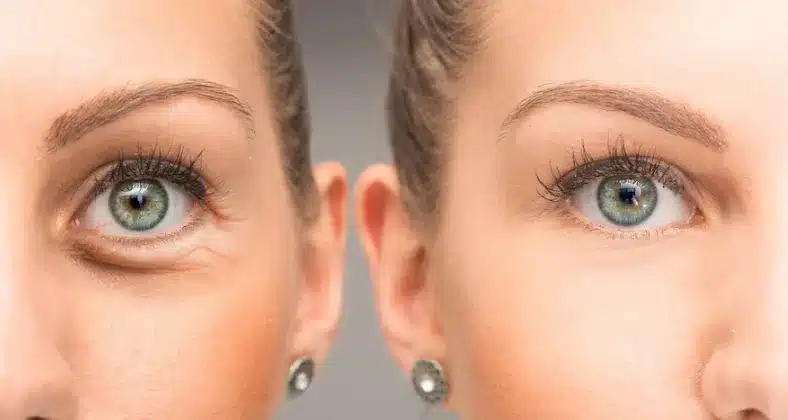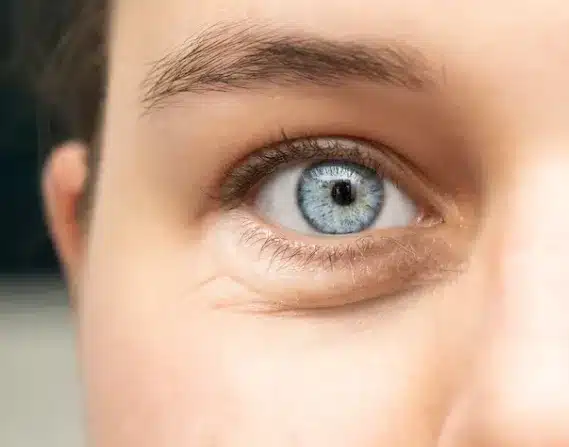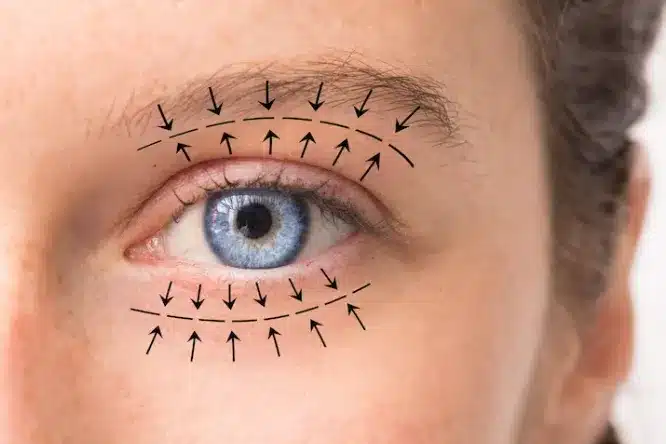Choosing between a brow lift and eyelid surgery (blepharoplasty) hinges on the specific aesthetic and functional issues an individual is aiming to address. A brow lift, including forehead lift and temporal brow lift techniques, is primarily focused on correcting sagging brows and forehead skin that contribute to a tired, angry, or aged appearance. This procedure can significantly enhance the upper face’s overall look, creating a more youthful and refreshed expression. It’s
What is Blepharoplasty?
Blepharoplasty is a surgical procedure performed to enhance the appearance of the eyelids. It addresses concerns such as sagging or drooping eyelids, under-eye bags, and puffiness, which can make individuals appear tired, aged or even impair their vision. This procedure can be performed on the upper eyelids, lower eyelids, or both, depending on the patient’s specific needs.

Procedure Steps
Blepharoplasty, commonly known as eyelid surgery, involves several key steps designed to remove excess skin, muscle, and sometimes fat from the eyelids to improve the appearance of the eyes and, in some cases, improve vision obstructed by drooping eyelids. The procedure can be performed on the upper lids, lower lids, or both. Here’s a general overview of the procedure steps for blepharoplasty:
Consultation and Planning
- Initial Consultation: The surgeon evaluates the patient’s eyelids, discusses goals, reviews medical history, and decides on the best surgical approach.
- Pre-operative Instructions: Patients receive guidance on preparing for surgery, including medication adjustments, smoking cessation, and avoiding certain supplements.
Anesthesia
- Administering Anesthesia: To ensure comfort during the procedure, the patient is typically given local anesthesia with sedation or, in some cases, general anesthesia.
Surgical Procedure
For Upper Eyelid Surgery
- Incision: A precise incision is made along the natural crease of the upper eyelid.
- Removal or Repositioning of Fat: Excess fat is either removed or repositioned to eliminate puffiness.
- Excess Skin and Muscle Removal: Excess skin and possibly muscle are trimmed to achieve a more youthful appearance.
- Closure: The incision is closed with fine sutures, which are either removed after several days or are absorbable.
For Lower Eyelid Surgery
- Incision: The incision is made just below the lashes in the natural crease of the eye or inside the lower eyelid (transconjunctival approach) to remove or redistribute excess fat. The latter does not leave a visible scar.
- Skin Removal: If necessary, excess skin is removed for a tighter, smoother lower eyelid.
- Closure: Similar to the upper eyelid, the incision is closed with fine sutures.
Recovery and Aftercare
- Immediate Aftercare: Patients may experience swelling, bruising, irritation, or dry eyes. Cold compresses and medication can help manage these symptoms.
- Follow-Up Visits: Post-operative appointments allow the surgeon to monitor the healing process and remove sutures if necessary.
Clinic contact number: +989371200167
The Multifaceted Benefits of Blepharoplasty
Blepharoplasty, widely recognized for its aesthetic and functional benefits, has been extensively studied by leading institutions and surgeons in the field of cosmetic surgery. Renowned universities such as Harvard Medical School and Johns Hopkins University have contributed significant research under the guidance of experts like Dr. Julie Woodward and Dr. Mark Codner, who have pioneered innovative techniques in eyelid surgery. Their work has not only enhanced the safety and efficacy of blepharoplasty but also broadened our understanding of its benefits. The Cleveland Clinic’s Cosmetic & Plastic Surgery Center stands out as one of the most active hospitals in this field, consistently pushing the envelope in surgical excellence and patient care.
Recent statistics underscore the growing popularity and recognized benefits of blepharoplasty. According to data from the American Society of Plastic Surgeons (ASPS), eyelid surgery ranks among the top five cosmetic surgical procedures performed in the United States, with over 211,000 procedures completed in the latest reported year. This number reflects a steady increase in individuals seeking blepharoplasty for its ability to address both cosmetic concerns and functional impairments. Patients report high satisfaction rates, noting significant improvements in visual field obstruction for those affected by ptosis or excess eyelid skin, as well as a rejuvenated appearance that contributes to a more rested and alert look. The procedure’s ability to deliver subtle yet transformative results underscores its value and continues to drive its popularity across diverse demographics.

Reasons to get Blepharoplasty:
Individuals seek eyelid surgery for various reasons. Some may have genetically inherited droopy or sagging eyelids, while others may develop these issues due to the natural aging process. Additionally, factors such as sun exposure, smoking, and stress can contribute to the appearance of tired-looking or puffy eyes. Eyelid surgery can help individuals regain a more youthful and alert appearance, boosting their self-confidence.

Best Candidates for Blepharoplasty:
The ideal candidates are generally healthy individuals with realistic expectations about the procedure. It suits those bothered by excess skin, bags under the eyes, or a tired appearance. While there is no specific age requirement, most candidates are over 35, as this is when the effects of aging become more noticeable. However, younger individuals with hereditary eyelid concerns may also be suitable candidates.
How Long Do Results Last After Eyelid Surgery?
If you opt for lower eyelid surgery (lower blepharoplasty), you can expect your results to last for a lifetime. If you opt for upper eyelid correction, you can expect your results to last for roughly five to seven years. The results of lower blepharoplasty last a lifetime because they are mostly derived from the removal of excess subcutaneous fat. On the other hand, the results of upper blepharoplasty are primarily derived from lifting sagging tissues.

Benefits of Blepharoplasty:
1. Improved appearance: One of the primary benefits of eyelid surgery is achieving a more youthful and refreshed look. This procedure effectively removes excess skin, fat, and muscle from the upper and lower eyelids, reducing puffiness, sagging, and wrinkles.
2. Enhanced self-confidence: By addressing concerns like droopy or baggy eyelids, eyelid surgery can boost self-esteem and self-confidence. Patients often experience a renewed sense of self-assurance, leading to improved social interactions and overall mental well-being.
3. Elimination of vision obstruction: In some cases, excessive skin on the upper eyelids can obstruct the field of vision, causing functional difficulties. Blepharoplasty can rectify this issue by removing the excess skin, allowing for improved peripheral and overall vision.
4. Long-lasting results: eyelid surgery provides long-lasting results, making it an excellent investment for those seeking a permanent improvement in the appearance of their eyes. While the natural aging process will continue, the effects of the surgery typically remain noticeable for many years.
5. Reduction of under-eye bags: eyelid surgery eliminates under-eye bags, which can make a person appear tired or older. Removing excess fat and tightening the skin results in a smoother, more rejuvenated under-eye area.
6. Correction of ptosis: Ptosis refers to drooping of the upper eyelids, which can interfere with vision and make a person appear tired or sad. Eyelid surgery can correct ptosis, lifting the eyelids and providing a more alert and vibrant appearance.
7. Minimally invasive procedure: eyelid surgery is a relatively simple and minimally invasive surgical procedure. It is typically performed outpatient, requires only local anesthesia, and involves minimal scarring, ensuring a quicker recovery than more extensive surgeries.
8. Complementary to other facial procedures: eyelid surgery can be combined with other facial rejuvenation procedures such as facelifts, brow lifts, or dermal fillers to achieve a comprehensive facial transformation. Combining procedures can result in a more harmonious and balanced overall appearance.
9. Natural-looking results: Skilled surgeons can achieve natural-looking results through blepharoplasty, ensuring that the eyes are not artificially altered or “done.” The procedure aims to enhance the eyes’ natural beauty while maintaining their unique characteristics.
10. Psychological well-being: Lastly, the benefits of eyelid surgery extend beyond the physical realm. By achieving a more youthful and rejuvenated appearance, patients often experience improved mental and emotional well-being. Feeling more satisfied with their appearance can positively impact various aspects of life, including personal relationships, career opportunities, and overall happiness.
Clinic contact number: +989371200167

Like other procedures in plastic surgery, the concept of blepharoplasty has evolved over the years secondary to increasing knowledge of periorbital anatomy, facial topography, and the aging process. Aestheic Surgery Journal
Risks of Blepharoplasty
Eyelid surgery, also known as blepharoplasty, is a cosmetic procedure that focuses on improving the appearance and function of the eyelids. The eyes are often considered one of the face’s most prominent and expressive features, and eyelid surgery can enhance their overall aesthetic appeal while addressing functional issues such as drooping or sagging eyelids.
While blepharoplasty is generally safe, as with any surgical procedure, some risks are involved.
Infection
Any surgical procedure carries a risk of infection, and eyelid surgery is no exception. Infections can occur at the incision site and may result in inflammation, redness, pain, or discharge. In severe cases, infections can lead to fever and require additional treatment, such as antibiotics or surgical drainage.
Scarring
Although efforts are made to minimize scarring during eyelid surgery, there is still a risk of visible scars. The extent of scarring can vary depending on individual factors such as skin type and healing ability. In some cases, hypertrophic or keloid scars may develop, which are raised and thicker than the surrounding skin.
Dry eyes
Some individuals may experience temporary or permanent dry eyes following eyelid surgery. The surgery can disrupt tear production or alter the eyelid’s ability to spread tears evenly across the eye surface. Dry eyes can cause discomfort, redness, blurry vision, and increased sensitivity to light. Artificial tears or other lubricating eye drops may be necessary to manage this condition.
Dry eyes are a recognized risk associated with blepharoplasty, also known as eyelid surgery. This condition can occur when the procedure affects the eye’s natural ability to produce sufficient tears for lubrication. Here are some key points regarding dry eyes in the context of blepharoplasty risks:
Cause
During blepharoplasty, alterations made to the eyelids can potentially disrupt the delicate balance of the tear film that covers the eye’s surface. If the eyelids are unable to close fully or if the tear production is somehow impaired, it can lead to dry eyes. This is particularly a concern in cases where aggressive skin removal or muscle alteration affects the eyelid’s function.
Symptoms
Symptoms of dry eyes post-blepharoplasty can include a persistent dry sensation, irritation, a feeling of grittiness or scratchiness in the eye, sensitivity to light, and even blurred vision. These symptoms can range from mild to severe and may impact daily activities and comfort.
Temporary vision changes
In rare cases, individuals undergoing blepharoplasty may experience temporary vision changes. This can include blurred vision, double vision, or even difficulty closing the eyes completely. These symptoms usually resolve within a few days or weeks but can be distressing during recovery.
Asymmetry or unsatisfactory results
eyelid surgery aims to achieve symmetrical and aesthetically pleasing results. However, there is a risk that the outcome may not meet the patient’s expectations. Individual healing, tissue response, or surgical technique can contribute to asymmetry or unsatisfactory results. In some cases, revision surgery may be required to address these issues.

Summary:
Choosing between eyebrow lift surgery and cosmetic blepharoplasty depends largely on the individual’s specific aesthetic goals and the areas of the face they wish to rejuvenate. Eyebrow lift surgery, which encompasses various brow lift techniques including the temporal brow lift, is designed to raise the position of the eyebrows, providing a more alert and youthful appearance. This procedure is particularly beneficial for individuals looking to correct a sagging brow or reduce forehead wrinkles, contributing significantly to periorbital rejuvenation. For those hesitant about undergoing surgery, non-surgical brow lift options, utilizing injectables or ultrasound technology, offer a less invasive approach to achieving a subtle lift and improvement in brow position.
On the other hand, cosmetic blepharoplasty targets the eyelids directly, removing excess skin, muscle, and sometimes fat from the upper and/or lower eyelids to alleviate droopiness and puffiness around the eyes. This procedure can significantly enhance the eye’s appearance, making it look more rested and vibrant. The choice between a brow lift and eyelid surgery ultimately hinges on whether the primary concern lies with the position and contour of the eyebrows or with the condition of the eyelids themselves. A thorough consultation with a qualified plastic surgeon can help determine the most appropriate procedure to achieve desired periorbital rejuvenation, taking into account the unique facial structure and aesthetic goals of the individual.
Clinic contact number: +989371200167
FAQs:
1. Can blepharoplasty improve vision?
Yes, one of the functional benefits of blepharoplasty, especially upper eyelid surgery, is the improvement of vision. For individuals with severely drooping eyelids, the excess skin can obstruct peripheral vision. By removing the excess tissue, blepharoplasty can clear this obstruction, leading to a broader field of view and improved vision.
2. How does blepharoplasty affect the appearance of aging?
Blepharoplasty can significantly rejuvenate the appearance of the face and eyes. By removing excess skin and fat from the eyelids, the procedure can reduce bagginess under the eyes and correct droopy eyelids, making the eyes look younger and more alert. This can contribute to a more refreshed and youthful overall appearance.
3. Can blepharoplasty reduce wrinkles?
While blepharoplasty primarily targets the removal of excess skin and fat from the eyelids, it can also contribute to a reduction in the appearance of fine lines and wrinkles around the eyes, particularly in the lower eyelid area and crow’s feet. However, it’s important to note that blepharoplasty is not a substitute for procedures specifically designed to address wrinkles, such as Botox or facelifts.
4. Is there a benefit for dry or irritated eyes?
For some patients, blepharoplasty can help alleviate symptoms of dry or irritated eyes. In cases where excess eyelid skin contributes to irritation by causing the eyes to remain partially open during sleep or interfering with proper blinking, eyelid surgery can help. By correcting these issues, blepharoplasty may reduce eye dryness and irritation. However, it’s crucial for patients with these symptoms to consult with an ophthalmologist or a plastic surgeon who specializes in eyelid procedures to determine the appropriate treatment.
5. What are the psychological benefits of blepharoplasty?
Beyond the physical improvements, blepharoplasty can offer significant psychological benefits. Many patients report increased self-confidence and satisfaction with their appearance post-surgery. The enhancement in facial appearance can lead to positive social and psychological effects, including a better quality of life and improved mental health.
When considering blepharoplasty, it’s essential to consult with a board-certified plastic surgeon who can discuss the potential benefits and risks based on your specific condition. They can help you understand what the surgery can realistically achieve and whether it’s the right option for your needs.
Blepharoplasty: Anatomy, Planning, Techniques, and Safety | Aesthetic Surgery Journal | Oxford Academic (oup.com)
I Got a Lip Lift to Fix My Smile After a Nose Job | Real Self News



